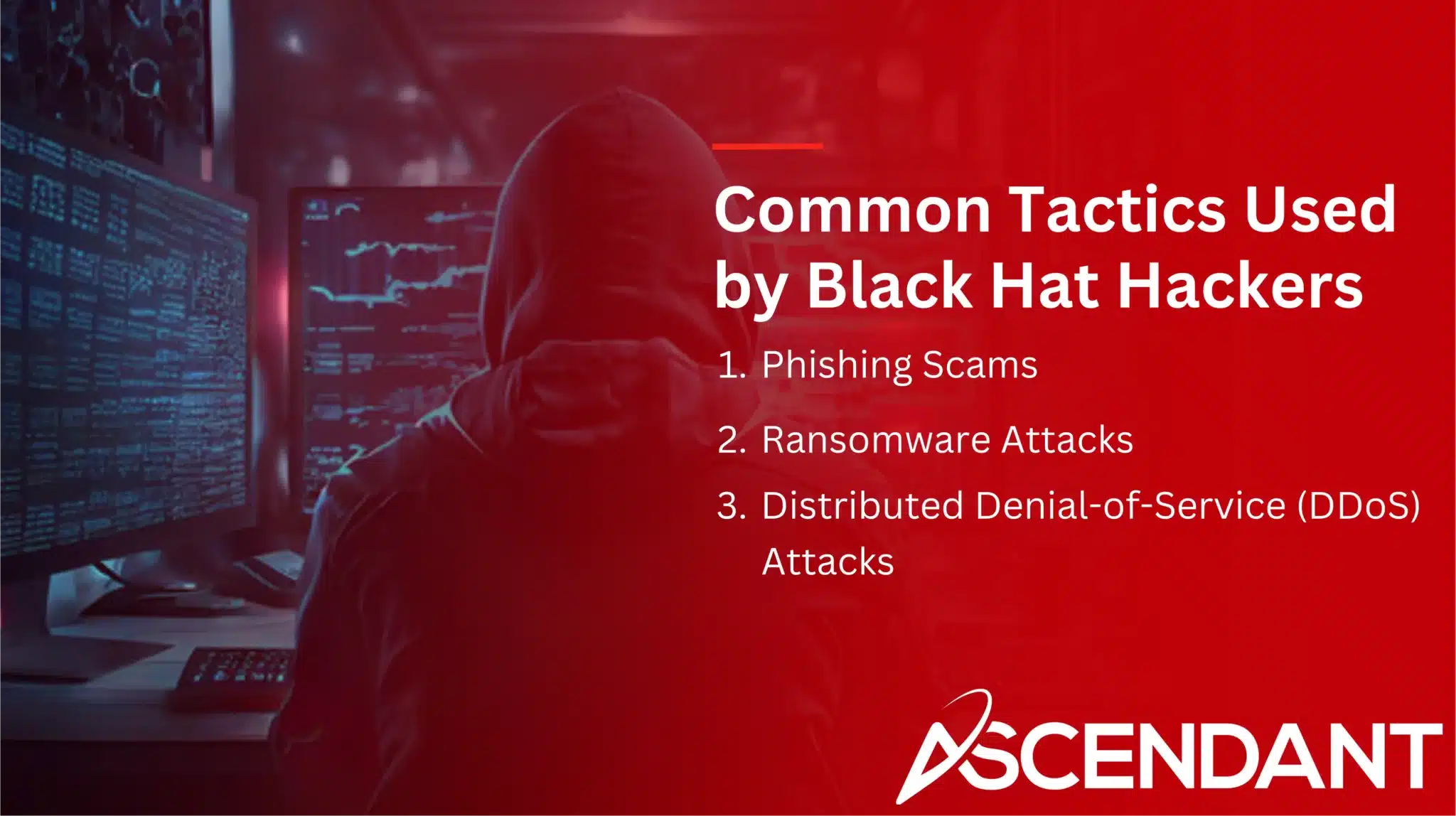Black hat hackers are cybercriminals who infiltrate systems to steal data and cause damage. They target vulnerabilities for personal gain, making them a significant threat to individuals and organizations. This article explores who they are, their motives, common tactics, and how you can protect yourself.
Key Takeaways
- Black hat hackers exploit vulnerabilities for financial gain and can operate alone or as part of organized groups, often using tactics like phishing and ransomware.
- Robust cybersecurity measures, including firewalls, regular updates, and employee training, are essential for organizations to protect against black hat hackers.
- The ongoing emergence of technologies like AI and 5G presents new challenges for cybersecurity, requiring organizations to stay informed and adapt their defenses accordingly.
Who Are Black Hat Hackers?
Individuals identified as black hat hackers access computer networks unlawfully and with malintent, commonly deploying malware and pilfering sensitive data. These attackers illegally penetrate systems to capitalize on security weaknesses for their personal or financial benefit. In stark contrast to white hat hackers, who comply with ethical standards and work towards enhancing system defenses, black hats engage in activities driven by malicious intent against both private citizens and enterprises.
The echelon of these cybercriminals spans from adept individuals to less experienced ones known as “script kiddies,” the latter utilizing off-the-shelf software tools for breaching networks. Organized crime syndicates may incorporate such skilled black hats into their ranks for complex criminal endeavors. Their tactics often include taking advantage of existing flaws within software programs, precipitating substantial data breaches that can severely disrupt business operations. They use the dark web’s anonymity for communication among themselves while swapping methods and hacking instruments.
Financial enrichment remains a key motive behind the actions undertaken by black hat hackers. They frequently concoct false personas intended to trick unsuspecting victims into surrendering confidential information—underscores this point—the importance of recognizing these adversaries lies in bolstering our own defensive measures against potential incursions by them.
Motivations Behind Black Hat Hacking
Black hat hackers are often motivated by the prospect of monetary rewards. Numerous black hat individuals partake in illicit activities to extract sensitive data or infiltrate systems with financial motives in mind. This frequently entails trading stolen information on the dark web or imposing ransoms for the decryption of hijacked data. The temptation of rapid financial returns is a compelling draw, especially when perceived risks of detection appear minimal.
Not every black hat hacker pursues hacking endeavors solely for money. Some embark upon such ventures driven by personal vendettas or guided by ideological principles, aiming their digital assaults at particular people or entities they oppose to exact retribution through turmoil and destruction.
Some hackers revel in the sheer challenge and gratification that comes with successfully penetrating secure systems. These various incentives highlight the multifaceted nature inherent within black hat hacking circles and underscore an essential need for comprehensive cybersecurity defenses.
Common Tactics Used by Black Hat Hackers
Black hat hackers utilize various strategies to carry out their nefarious intentions. They engage in activities such as launching phishing scams with the aim of capturing sensitive information or initiating ransomware assaults that deny victims access to their own data, continually creating innovative ways to take advantage of vulnerabilities.
Acknowledging these prevalent techniques is crucial for strengthening protective measures against possible dangers.
Phishing Scams
Black hat hackers frequently employ phishing scams, using sophisticated social engineering methods to deceive individuals into disclosing their confidential information like login credentials and financial details. These malefactors craft misleading communications that seem authentic, mimicking reputable companies or credible persons in order to entice victims into clicking on pernicious links or downloading harmful files.
The fallout from succumbing to a phishing scam can be catastrophic, often resulting in identity theft as well as considerable economic detriment. Phishing attacks serve as an entry point for many black hat hackers who embark upon their nefarious activities by mastering these relatively simple yet lucrative schemes.
By understanding the mechanics behind such fraudulent acts, both people and entities can enhance their defenses against these insidious threats posed by black hats engaging in phishing escapades.
Ransomware Attacks
Black hat hackers are notorious for executing ransomware attacks, wherein they unlawfully infiltrate computer networks and encrypt the files of their victims. They then extort payment in return for the keys to decrypt these files. The intent behind such actions is harmful and can severely disrupt operations, leading to substantial economic losses and tarnishing reputations.
The consequences of these ransomware assaults are often catastrophic, with victims losing access to crucial data. Paying off the attackers doesn’t always guarantee that access will be regained.
These malevolent black hats typically prey on entities with lax network security by leveraging known weaknesses to carry out their schemes. Understanding how ransomware operates is vital for organizations so they can devise robust measures against it.
Distributed Denial-of-Service (DDoS) Attacks
By inundating a server with an excess of traffic, typically from a botnet, DDoS attacks aim to impair or completely interrupt the provision of online services. These assaults make it impossible for servers to process legitimate inquiries due to the overload caused by black hat hackers who seek to create disorder and disrupt operations.
DDoS attacks have consequences that extend well beyond just the entity under attack. They also affect its customers and users. Understanding how these attacks function is essential in developing strong protective strategies against them. It underscores why robust cybersecurity protocols are crucial in safeguarding internet-based services from such invasive interruptions perpetuated by black hats.
Notable Examples of Black Hat Hacking
Instances of black hat hacking in the real world have demonstrated the profound impact these nefarious actions can have. Kevin Mitnick, who stands out as an infamous black hat hacker, compromised more than 40 corporations and laid bare their security shortcomings. Meanwhile, Julian Assange, known for founding WikiLeaks, gained notoriety through his hacking exploits that brought sensitive governmental data to light.
The notorious example set by Barnaby Jack involved manipulating ATMs to eject money openly, highlighting how even financial systems could be exploited due to vulnerabilities. These high-profile events serve as a stark reminder of the sectors’ critical weak points and emphasize why stringent cybersecurity is paramount.
A closer examination of these incidents offers indispensable insights into the potential ramifications of engaging in black hat hacker activities while stressing continuous alertness’s necessity within cyberspace security practices.
Differences Between Black Hat, White Hat, and Gray Hat Hackers
In the complex realm of hacking, there exists a spectrum that extends beyond mere black and white. It also encompasses varying degrees of gray. Black hat hackers are typically driven by personal gain, exploiting weaknesses either for monetary rewards or as an act of revenge. Gray hat hackers, Straddle the line between right and wrong differently than white hat hackers who adhere strictly to legal parameters with intentions to bolster security measures. These individuals often bypass consent to reveal vulnerabilities but purport their endeavors serve a greater good.
Often operating solo, gray hat hackers gravitate towards recognition rather than pecuniary rewards. They habitually disclose security shortcomings in public forums which may inadvertently lead to collateral damage—a reflection on the ambiguous legality surrounding their activities within the community known as gray hats.
Conversely, white hat hackers stand out as ethical specialists focused on aiding entities fortify their cyber defenses while ensuring compliance with cybersecurity standards. A practitioner donning this “white” mantle fully understands these divergences and recognizes how they illuminate the moral fabric spanning across hacking practices—including those embraced by fellow “white hats”.
How Organizations Can Protect Against Black Hat Hackers
Organizations can take several steps to protect themselves from black hat hackers. Robust cybersecurity measures, like firewalls and regular software updates, are key to safeguarding against unauthorized access.
Employee training also plays a crucial role in recognizing and mitigating cyber threats.
Implementing Firewalls
Firewalls play an essential role in safeguarding computer networks from unauthorized entry and potential cyber-attacks. To bolster network security, it’s important to configure firewalls with robust passwords, restrict administrative privileges, and design organized segments within the network that control traffic flow for increased protection.
To effectively regulate the movement of data and thwart unsanctioned transmissions, access control lists (ACLs) must be meticulously tailored. It is vital to conduct routine checks on firewall settings to guarantee their continued efficacy in filtering out undesirable traffic. Sustained vigilance through constant management and surveillance is imperative in preserving a firewall’s capability to counteract emerging threats.
Regular Software Updates
It is crucial to update software consistently to mitigate security loopholes that black hat hackers could take advantage of. By applying patches through updates, one can address known vulnerabilities, thereby lessening the chance of illicit access and bolstering overall security.
Equally important is the training of employees in recognizing and dealing with cyber threats. Through ongoing educational sessions, workers learn to spot phishing efforts and various malevolent acts which diminish the organization’s susceptibility. A combination approach of maintaining current software and providing staff education greatly enhances an entity’s defenses against cybersecurity threats.
Employee Training
Comprehensive IT security awareness training is crucial, as employees can frequently be the most vulnerable point in an organization’s defenses. Such programs need to extend beyond simple online quizzes and should instruct employees on how to maintain secure practices, particularly when it comes to using personal devices.
Ongoing education in cybersecurity enables staff members to identify signs of cyber attacks and keeps them informed about new threats that may arise. It’s important that this training emphasizes adherence to policies for computer usage while also clearly explaining the consequences of policy breaches.
To remain effective, these training initiatives must be refreshed periodically so they stay aligned with changing cybersecurity challenges and updated best practice approaches for security.
The Role of Ethical Hacking in Cybersecurity
By proactively spotting weaknesses before they are taken advantage of by malicious hackers, white hat hacking serves to bolster the defense mechanisms of organizations. Known as white hats, these ethical hackers employ their expertise in a manner similar to adversaries in order to evaluate and reinforce security systems, enabling enterprises not only to shore up their protections but also adhere to cybersecurity mandates.
There’s an escalating need for individuals skilled in cybersecurity, including those specialized in ethical hacking. With compensation figures spanning from $93,400 to $118,169 annually, this career offers substantial financial incentives alongside its significance.
Through the detection and resolution of system vulnerabilities by white hat professionals or ethical hackers, corporations can fortify themselves against looming cyber attacks—enhancing overall security integrity across platforms.
Legal Consequences for Black Hat Hacking
The activities of black hat hackers present considerable challenges for law enforcement agencies, particularly due to the difficulties posed by international jurisdiction and online anonymity. The repercussions for those engaging in black hat hacking can be quite serious. Under the provisions of the Computer Fraud and Abuse Act (CFAA), convicted individuals may face imprisonment ranging from one year up to 20 years, depending on how grave their offense is.
In instances where unauthorized access leads to the acquisition of national security information, perpetrators may receive prison sentences between 10 and 20 years. These legal penalties underscore the significant hazards associated with participating in black hat hacking endeavors—these include extensive incarceration periods as well as prosecution that could extend beyond domestic borders. Recognizing these dangers can act as a deterrent for those contemplating involvement in black hat activities.
Emerging Trends in Black Hat Hacking
The realm of black hat hacking is perpetually transforming, as new tendencies arise that augment the challenges faced by cybersecurity professionals. Cyber adversaries are progressively leveraging machine learning and artificial intelligence to magnify both the intricacy and reach of their illicit cyber activities. These advancements permit these hackers to streamline their attacks and refine how they select targets.
Black hat practitioners utilize AI-driven techniques to sift through extensive datasets, which aids them in pinpointing exploitable weaknesses within digital frameworks. With 5G technology ushering in greater levels of connectivity, there arises additional avenues for these malevolent actors – black hats – to intrude upon and take advantage of network vulnerabilities.
Maintaining an awareness of the ever-changing landscape is crucial for crafting potent defense mechanisms against these continuously advancing online threats that challenge information security.
Summary
In this article, we’ve delved into the realm of black hat hackers, examining their objectives and methods for exploiting weaknesses. We’ve discussed everything from phishing schemes to ransomware campaigns, drawing attention to the substantial threat these nefarious individuals pose to both people and enterprises. It’s crucial to recognize the distinctions among black hat, white hat, and gray hat hackers in order to fully understand where they fall on the ethical hacking continuum.
Taking steps such as deploying firewalls, updating software routinely, and conducting thorough staff training can help shield organizations against attacks by black hat hackers. Ethical hacking is equally important in spotting security loopholes before malicious actors have a chance at them. With cyber threats constantly evolving, it’s imperative that one remains vigilant and forward-thinking in safeguarding our digital infrastructure against potential breaches.
 Frequently Asked Questions
Frequently Asked Questions
What are black hat hackers?
Black hat hackers are individuals who engage in illegal activities by accessing computer networks with malicious intent, primarily to steal information or disrupt systems. Their actions pose significant risks to security and privacy.
What motivates black hat hackers?
Black hat hackers are primarily driven by financial gain, personal vendettas, the thrill of the challenge, and occasionally ideological beliefs. Their motivations can vary, but these factors are often at the core of their actions.
How can organizations protect against black hat hackers?
To safeguard against black hat hackers, organizations must enforce strong cybersecurity protocols. This includes the establishment of firewalls, consistent updates to software, and thorough training for all employees.
It is vital that such security measures are treated as a high priority in order to preserve organizational integrity.
What are the legal consequences of black hat hacking?
Engaging in black hat hacking is fraught with significant legal risks, such as the potential for substantial incarceration periods pursuant to statutes like the Computer Fraud and Abuse Act (CFAA), along with facing prosecution on an international level.
Recognizing the grave repercussions of participating in these unlawful practices is essential.
What are some emerging trends in black hat hacking?
Emerging trends in black hat hacking include the automation of attacks using machine learning and AI, as well as the security challenges presented by increased connectivity through 5G technology.
These developments underscore the evolving landscape of cybersecurity threats.


